The end of the blogging drought, if not the real one...
 Monday, October 5, 2009 at 10:20PM
Monday, October 5, 2009 at 10:20PM I know this will come as a great shock to you, but yes, I’m back… Life has become rather hectic and I don’t promise to update this blog as much as I used to but I will try to do better than I have been doing recently!
So, I’ll start with the bad news: Since I last wrote an entry, back in February this year, we have had NOT A SINGLE DROP of rain. It’s a desperate situation, with animals starving and dying, not to mention people too. I’m not going to try to catch up on all the goings-on since I last wrote, but here you can see how thin the buffalo already were back in June…fast-forward another 3 months of no rain and you can imagine how thin and frail they are now…
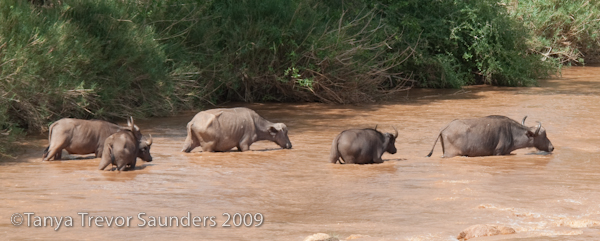
And look how red and dry the Yatta Plateau was back in June, and it’s only become hotter and drier since then:
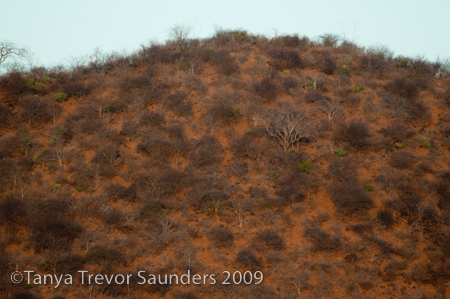
Our poor geese appeared on the dwindling river with their brand new brood but sadly not a single little one made it, for there was no cover (the river being so shallow and narrow by this point that there was nowhere to hide) and very little to eat too…
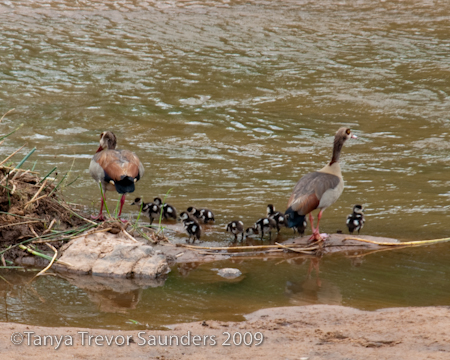
And then the inevitable happened: the river stopped flowing… 6th September was the day the water stopped:
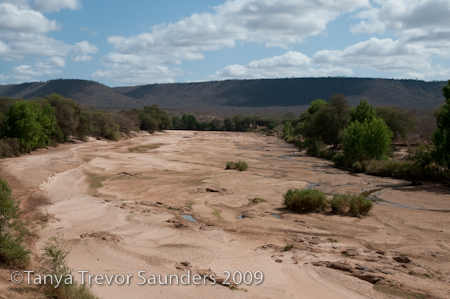
And very soon, there was no water left in the river at all, bar a couple of tiny, shrinking pools:
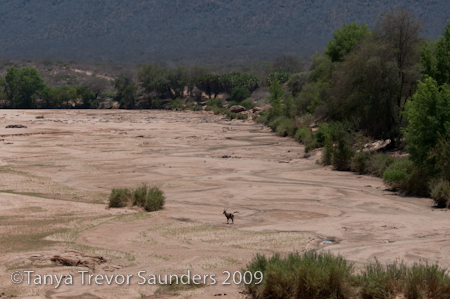 Looking upstream from the house…
Looking upstream from the house…
And downstream…
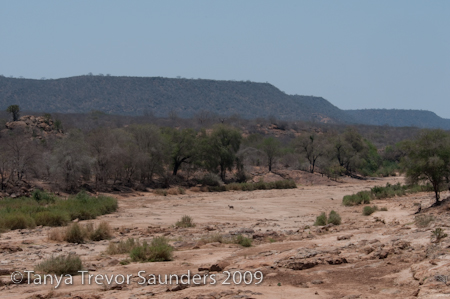
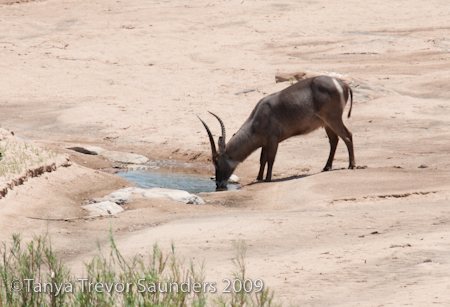 A thirsty waterbuck gets what he can…
A thirsty waterbuck gets what he can…It’s rather unsettling how such a harsh, unforgiving landscape can still be so achingly beautiful…and awe-inspiring how any of the animals survive at all, with so little to eat and hardly a drop to drink.
The elephants have learned the secret of surviving the drought and help a few other animals along the way. They know that, beneath the dry riverbed, a subterranean flow still exists, and they dig in the riverbed until they reach the underground water. Once they’ve had their fill, other animals can come and drink from the holes. To make things easier for all the animals, we’ve dug a larger waterhole in the sand in front of the house, where all sorts of animals and birds now quench their thirst. Digging in the sand to reach the underground water...
Digging in the sand to reach the underground water...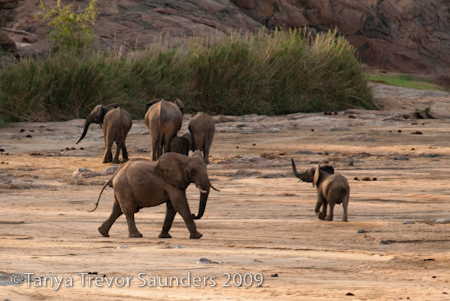


And of course the underground water beneath the sandy riverbed also provides enough moisture to keep a thin smattering of grass alive, which is mercilessly harvested by one and all…
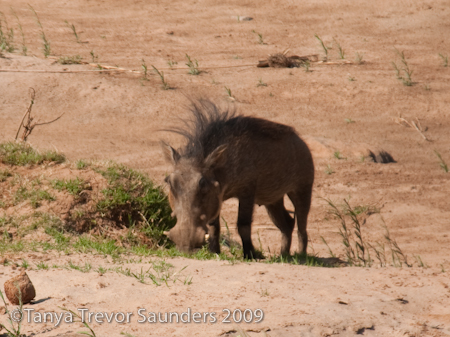 Warthog (above) and Lesser Kudu (below)
Warthog (above) and Lesser Kudu (below)
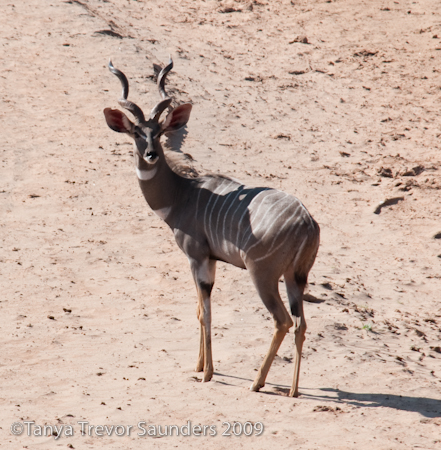
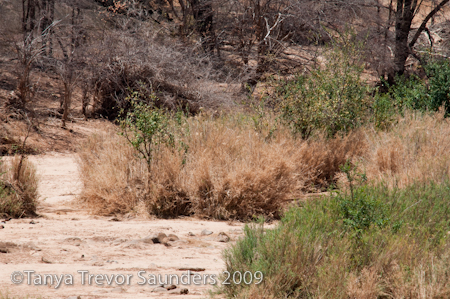 Despite the underground flow, the reeds are dying
Despite the underground flow, the reeds are dying
It’s not hard to imagine why our house and garden have become a bit of an oasis to many animals since the drought really started digging its heels in. We are still watering the lawn around the house with water pumped up from a hole dug in the sandy river (just like the elephants!) and this lawn feeds a “herd” of dikdiks by day, as well as hippos, hares and who knows what else by night.
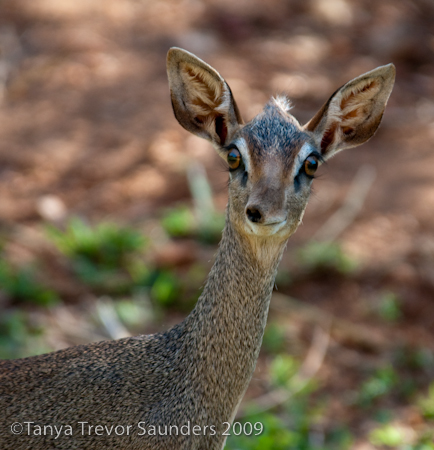 A twitchy-nosed dikdik on the lawn...and a hippo footprint on our patio!
A twitchy-nosed dikdik on the lawn...and a hippo footprint on our patio!
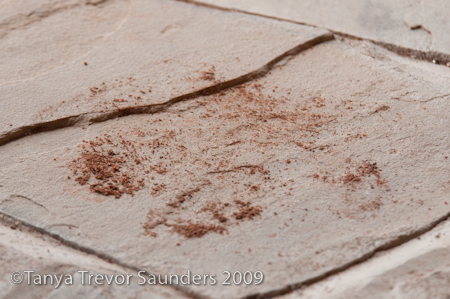
It’s amazing how many friends you can make when they’re hungry and you have the food! I am feeding an increasing number of animals each day, and they are all becoming increasingly tame.
First up are the sparrows and doves who wait impatiently for their millet seed in the morning. If I am not out of bed in time, they come and flutter around frantically in the bushes outside our bedroom window – whether or not that’s deliberate, I’m not sure but it certainly seems to be!
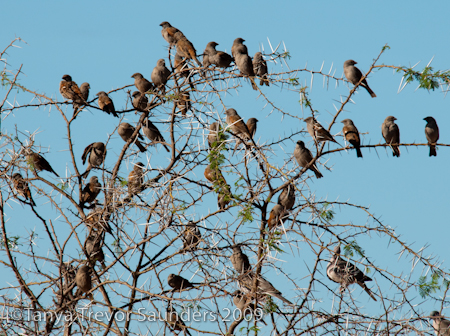
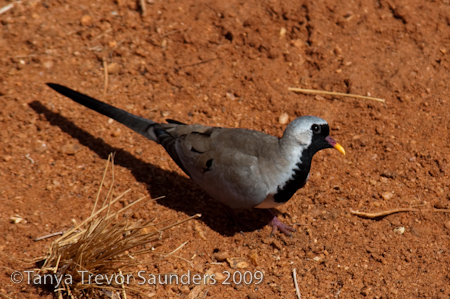
Even the pretty Namaqua Doves (above) have been coming for the seed, to join the Mourning Doves, the Laughing Doves and the Emerald-spotted Wood Doves.
Then the kitchen scraps from yesterday’s dinner and today’s breakfast go out for the dikdiks and – inevitably – the vervet monkeys too. I have stopped getting stressed by the monkeys trying to steal all the food – after all, they’re hungry too – and the dikdiks seem to have learnt to stand up for themselves and not be intimidated by the monkeys.
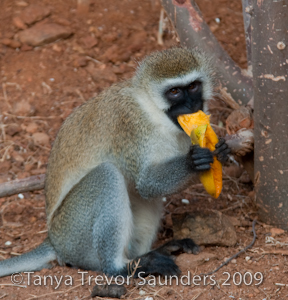
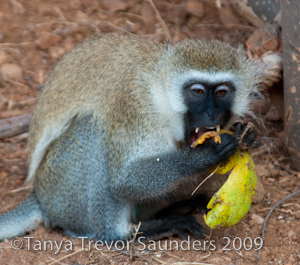
Around lunchtime, I also put out a pile of maize (corn) for the dikdiks, which is “shared” with the monkeys and the squirrels. The dikdiks are so tame now, they come rushing up to me as soon as I appear with their maize, and they will quite happily feed right next to me. (I’m happy to say the monkeys still have a little more respect, and keep their distance until I walk away, at which point they come rushing in.) At the same time, I put out more bird seed, for by then the Crested Francolins have arrived, as have the relative new-comers, a pair of Yellow-necked Spurfowl. The crowds of sparrows and doves also come flocking back down for round two.
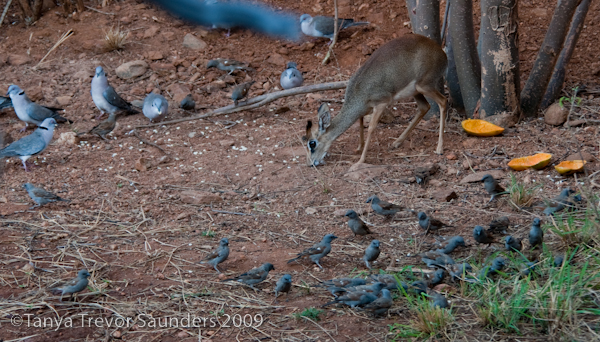 Dikdik surrounded by birds
Dikdik surrounded by birds
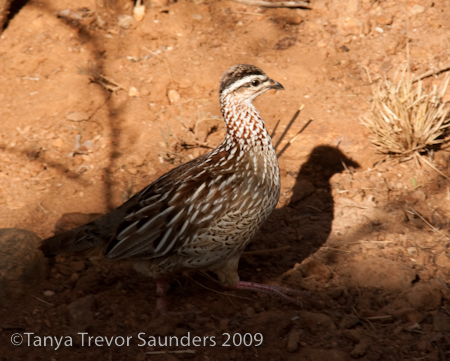 Crested Francolin (above) and Yellow-necked Spurfowl (below)
Crested Francolin (above) and Yellow-necked Spurfowl (below)
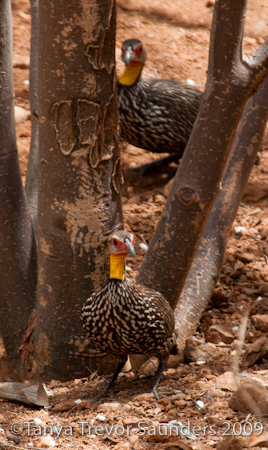
You can bet your bottom dollar that when the fruit and vegetable scraps go out, Slim (our black-tipped mongoose) and her now very big baby turn up, asking where the carnivore rations are, so it’s back to the fridge to see what meaty or cheesy left-overs I can find for them.
However, when the Banded Mongooses turn up, then Slim gets elbowed out the way by these boisterous, noisy beasts who are more heavily built than the Black-tipped Mongoose and of a much more aggressive temperament it would seem. Ian and I refer to them as the “terrestrial piranhas” because watching them dive onto the food I throw out for them is rather like watching a shoal of piranhas devour some hapless prey. Nonetheless, I have a real soft spot for our band of Banded Mongooses. They don’t come by every day, but when they do, they are a barrel of laughs.
A case in point was the day I first put out a basin of water for the dikdiks and other animals to drink from, just outside the kitchen window. I thought this would prevent them having to cross the endless expanse of sand to reach the waterhole in the riverbed (where they make easy pickings for eagles). The Banded Mongooses obviously thought this basin of water was just the ticket and put there just for them…and it seemed that nothing short of total submersion in the water was enough for them!
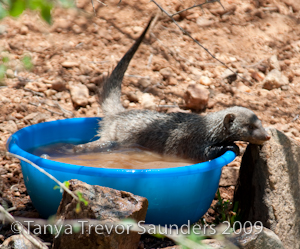
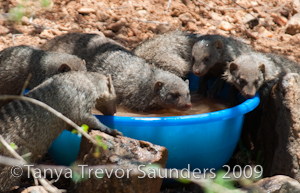
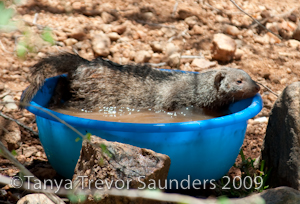
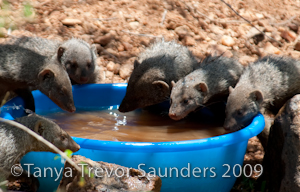
After their bath, the mongooses have a great time rolling around on the lawn and in the dust, and then continuing to forage for insects in the damp earth beneath the lawn or beg for scraps from the kitchen, as the case may be.
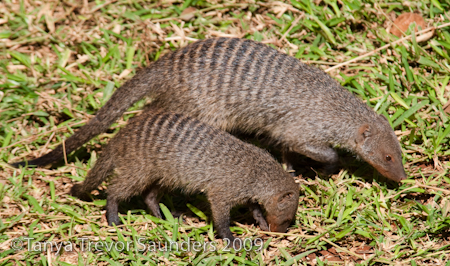
The Monitor Lizard also seems to like the lawn…perhaps because it is cool or perhaps because it too has discovered that the lawn is the only place where there are insects to be had during these dry times.
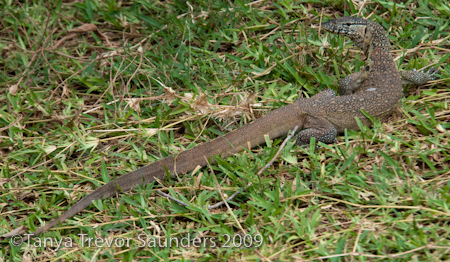
Our lovely genet cats still come by as soon as it gets dark, for the final feeding round of the day. Jean Genie and Two Notch Charlie have become so tame, feeding from our hands without a moment’s hesitation (In fact, as I write this, they are sitting on the carpet watching me.)
During daylight hours, it has been open season for the Martial Eagles with the wide open riverbed and nowhere for the dikdiks to hide. This poor little one was killed right in front of the house:
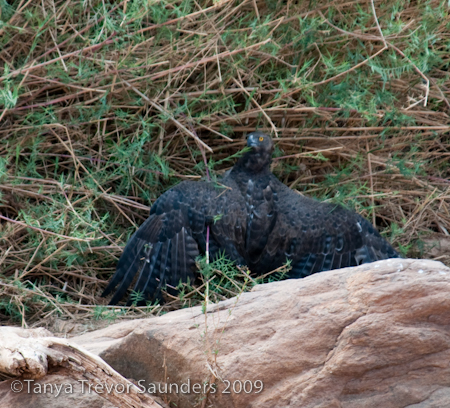 The Martial Eagle guards his kill. You can just see the dead dikdik in the reeds on the left hand side of the photo below.
The Martial Eagle guards his kill. You can just see the dead dikdik in the reeds on the left hand side of the photo below.
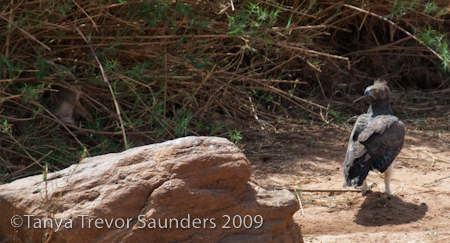
But here’s the lucky one who got away!


The hyraxes – those voracious devourers of green shoots – seem to be multiplying at a huge rate. They spend all day long in the bushes on the edge of the lawn which benefit from the sprinkler too.
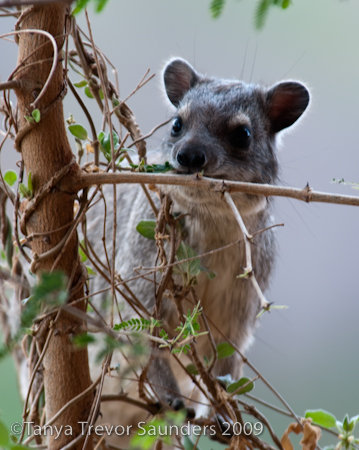
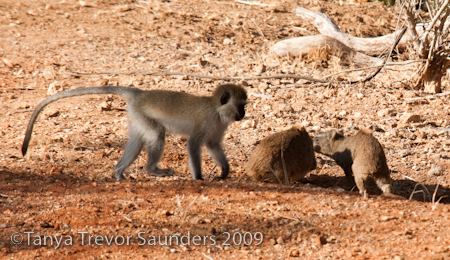 A baby Vervet Monkey runs up to a hyrax
A baby Vervet Monkey runs up to a hyrax
The hyraxes also feel quite happy chewing the plants on our balcony down to tiny stubs, the moment our back is turned.
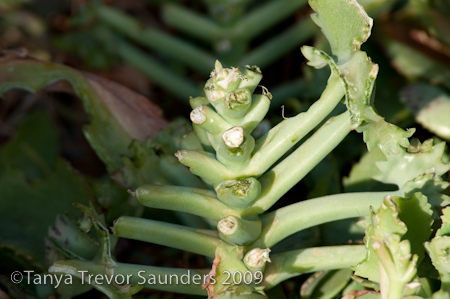
The Tree Squirrels have also decided that inside the house offers more creature comforts than outside, and have taken up residence in one of the holes in the posts on our balcony:
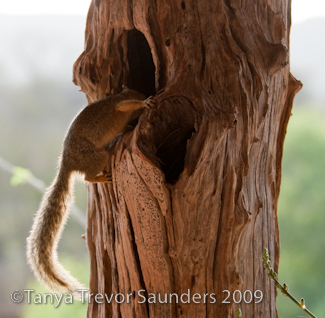
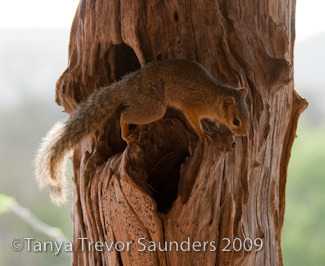
There’s no denying they’re very sweet (although they can become very destructive if let loose on carpets and upholstery…)
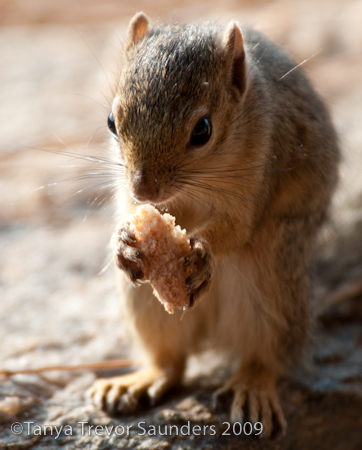
We’ve had a few other newcomers too. On 11th March (I know the exact date because I made a note of it), a Magpie Starling suddenly turned up with the glossy starlings. This bird was far out of its normal range, for it is usually found in the desert country further north-east of us. I wonder whether its venturing this far into Tsavo was an indication of how dry the country is here this year? (I didn’t get a photo, unfortunately.)
A beautiful Verraux Eagle Owl, giant of the owl world, came and perched in the doum palms near our house one evening, and I thought it looked rather lovely in the late light.
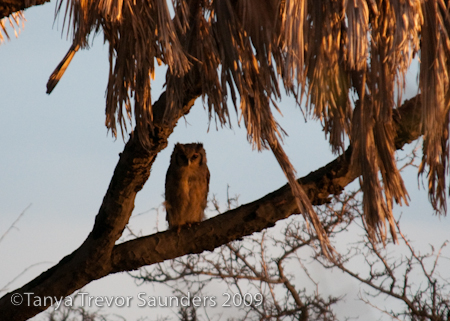
Last week a pack of Wild Dogs killed a waterbuck just up behind the house. These dogs have become quite rare over the years, but seem to be making a come-back in many parts of the country and – in spite of the hapless waterbuck – it’s truly wonderful to see them back here…
Well, that was a quick round-up to bring you back in touch with all the Kulafumbi regulars and the newcomers too…while we continue to wait for the rain. The birds are all courting and the Fireball Lilies are flowering, both of which are normally indications of imminent rain…but we won’t believe it until we see it!
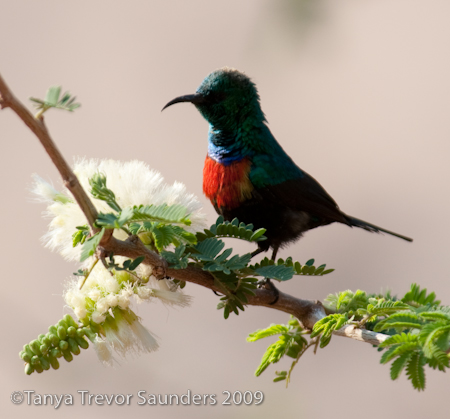 The Black-bellied Sunbird can always be found on the flowering acacias near the house (also benefiting from the lawn watering!)
The Black-bellied Sunbird can always be found on the flowering acacias near the house (also benefiting from the lawn watering!)
 8 Comments |
8 Comments |  Tanya | in
Tanya | in  "Our" Egyptian Goose Family,
"Our" Egyptian Goose Family,  Animals In House,
Animals In House,  Antelope (general),
Antelope (general),  Balcony Garden/Flowerbeds,
Balcony Garden/Flowerbeds,  Big Game (general),
Big Game (general),  Birds (eagles),
Birds (eagles),  Birds (general),
Birds (general),  Dik Diks,
Dik Diks,  Elephants,
Elephants,  Genet Cat,
Genet Cat,  Hippo Lawn,
Hippo Lawn,  Kudu,
Kudu,  Lizards,
Lizards,  Mongooses,
Mongooses,  Monkeys & Baboons,
Monkeys & Baboons,  Plants (general),
Plants (general),  Predators & Scavengers: other,
Predators & Scavengers: other,  River Level Low,
River Level Low,  Slim, the Black-Tipped Mongoose,
Slim, the Black-Tipped Mongoose,  Small Animals (general),
Small Animals (general),  Squirrels,
Squirrels,  Warthogs,
Warthogs,  Waterbuck
Waterbuck 




Reader Comments (8)
Hi Tanya,
great to see you blogging again. What a sight, the Athi all dried up....
Love the picture of the mongoose drinking together. Can't wait to meet all your new "friends" !
Audrey
Great update during trying times - it was worth the wait. Quite the contrast from the historic flooding in Okavango Delta in Botswana earlier this year.
Lovely to have you back. Have missed your wonderful photographs and eloquent and enthusiastic commentaries! The drought has been dreadful, hasn't it...but still such beauty and lust for life. I'm currently doing an Ecology course given by a guy who runs projects on Kenya's lakes...an interesting year for his team, I'm sure.
Please don't leave it so long next time.
Hope life is treating you well.
Nikki
So great to get an update from you, had nearly given up! Beautiful pictures and great commentary, as always. Will be praying for rain for you guys and for all the animals and plants that need it there!
Great Post, I just tweeted you
Like everyone else, I was wondering what had happened. I am so glad to see you back. The scenes of the drought are heart breaking and I applaud you for doing what you can. It must be amazing to have so many new pets.
I've heard that the rains have finally been falling liberally over Tsavo...Hope they have reached you!
It's wonderful to see you back to blogging. Your photos are wonderful, as they always are.
The photo of the river is shocking - have you ever seen it dry up before?